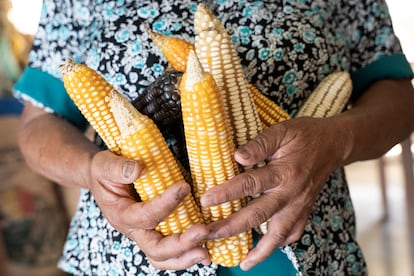For Carlos Arriola (Guatemala City, 54 years old) hunger is nonsense.
Just like the Guatemalan policies to stop it.
This doctor and researcher, with 31 years of experience in the Chortí area of Guatemala, points to social indifference as the root of the problem: “We are used to saying: 'she is
short
(short) like her father' or 'she is skinny like the mother', but what these children usually have is malnutrition,” she explains through a video call.
“And the Government only takes welfare or palliative measures.
For me, there is a malicious component of public policy of doing nothing to keep our population in the same conditions;
it is a political strategy to maintain the circles of poverty”.
One of every two children in Guatemala suffers from malnutrition;
46.5% according to the latest Maternal and Child National Survey, from 2014-2015.
The land of the quetzal already carried the title of being the sixth country with the highest hunger rates in the world and the first in Latin America.
A situation that, according to experts, has worsened in the last two years due to the pandemic and hurricanes Eta and Iota, which hit Central America in November 2020. "Although the situation worsens, it is still an invisible problem," Arriola assured. early February at the presentation of the Manos Unidas awareness campaign,
Our indifference condemns to oblivion
.
Experts speak of 30 years to change these trends, it takes a whole generation.
But this one, ours, has not done enough to put an end to it
Part of this invisibility has a lot to do with the people it affects.
Guatemala is a very unequal country and indigenous people are the worst off in all statistics, despite the fact that they are practically half of the population.
Around 40% of these communities live in extreme poverty and close to 80% are socially excluded.
Vulnerability and marginalization is the daily life of those who have become accustomed, says Arriola, to contempt.
The also professor at the Universidad San Carlos de Guatemala in Chiquimula remembers with particular impotence what a father of a family responded to when he commented that the rates of hunger were much higher among the ancestral peoples: “He told me: 'Look, doctor, Don't worry if a malnourished child dies, one of those Indians.
They have many children and feel nothing,
it doesn't matter to them;
if one dies, they have more.
They are not the same as us.'”
Corn or milpa is the main source of food in Guatemala, the sixth country with the highest rates of malnutrition in the world.Carlos Zaparolli / Manos Unidas
But few know more about pain and injustice than the inhabitants of the Chortí region.
The illiteracy rate is 72% and the Human Development Index, 0.38 in 2005. Twenty years ago, acute malnutrition was so common that the ethnic group was classified as a victim of famine.
Since that “bad international propaganda”, the policies of one government after another have basically been the delivery of food.
"No long-term measures," he criticizes.
Here, in the heart of the country, the doctor founded the Asociación Santiago Jocotán‐ASSAJO, a partner organization of Manos Unidas in Guatemala, in order to close these gaps.
Researcher and coordinator of the Table for Development and Food Security of the Copán Chortí commonwealth, this stubborn doctor was named Anonymous Hero in 2002 and Builder of Peace in 2006.
Coffee and bread
Resources are the key to being able to choose.
For the most vulnerable peasants in the country, the only food option during the weaning process is coffee and bread.
“There's a whole generation of babies that are feeding on that.
What nutrients do coffee and bread provide?
For this reason, the rate of severe growth retardation is close to 15%.
Indigenous children present statistics of 55.5%, according to data from Manos Unidas.
Social exclusion accompanies malnutrition, as it translates into low availability and access to food, lack of means to produce or buy it, and poor sanitary conditions or overcrowding.
"It's a chain of inequality that comes from colonial times," settles the doctor.
And it is, he says, the basis of all the injustices that pile up later.
“When they arrive at school, children do not have the capacity to learn like others who have had a good diet.
This is a permanent scourge, since the damage is irreversible and condemns them to heavy, poorly paid work, thus perpetuating the circle of poverty”, he laments.
For this reason, this disease that affects 165 million minors, according to Unicef, is known as life imprisonment.
Hunger, an upward trend
Guatemala is not the only country with rising rates of food insecurity.
2020 was, in fact, the year that Latin America experienced the hungriest in the last twenty.
The percentage grew by 30% from 2019 to 2020, bringing the number of people affected to 59.7 million.
There are 13.8 million more empty plates from one year to the next, and although the pandemic is the main reason, it is not the only one, since these alarming data have not stopped growing in the last six years.
Forced migration, natural disasters and climate change are behind this "dark scenario" in what is already the region of the world where statistics have increased most drastically, reflecting a devastating situation: 267 million victims of food insecurity and 106 million adults with obesity.
"Sometimes I wonder what will happen in the next 30 years," reflects the Guatemalan after a long sigh.
“I don't think there will be much change if there isn't a different intention to develop strategies.
We have been dragging the rates we are talking about today for eight years.
And it hasn't gotten much better.
Experts speak precisely of 30 years to change these trends, it takes a whole generation.
But this one, ours, has not done enough to put an end to it.”
You can follow PLANETA FUTURO on
,
and
, and subscribe
to our 'newsletter'
here
.

